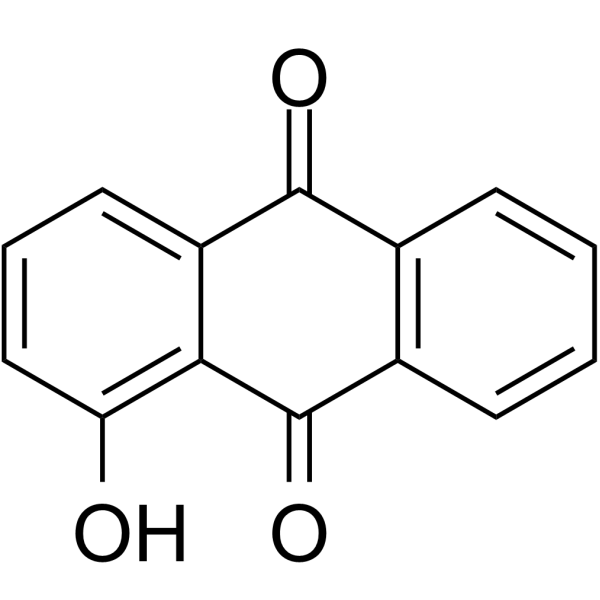
| 规格 | 价格 | 库存 | 数量 |
|---|---|---|---|
| 500mg |
|
||
| Other Sizes |
|
| 靶点 |
Naturally occurring anthraquinone
|
|---|---|
| 体外研究 (In Vitro) |
1-羟基蒽醌是从茜草、巴戟天和丹桂的根中,从大戟科的心材和草本决明子中分离得到的。
|
| 体内研究 (In Vivo) |
1-羟基蒽醌 (HA) 对 DNA 修复产生有效的反应,并且对大鼠具有致癌性[1]。
研究了天然化合物1-羟基蒽醌(HA)的致癌潜力。将60只1.5个月大的雄性ACI/N大鼠分为两组。第1组(30只大鼠)在整个实验期间(480天)喂食含有1%浓度HA的饮食。第2组(30只大鼠)作为对照组,仅给予基础饮食。第1组29只有效动物中有25只在盲肠或结肠上部发生腺瘤或腺癌,大肠肿瘤/荷瘤大鼠的平均数量为2.3。除了这些肠道肿瘤外,在12只大鼠中观察到肝肿瘤(肿瘤结节和肝细胞癌),在5只动物中观察到良性胃肿瘤;第2组的大鼠没有出现任何这些肿瘤类型的发展。与第2组相比,第1组的大肠、肝脏和胃肿瘤发生率均显著(分别为P小于2 x 10(-13)、P小于5 x 10(-5)和P小于3 x 10(-2)),这清楚地表明HA对大鼠具有致癌性。[1] |
| 动物实验 |
Animal/Disease Models: Thirty rats[1].
Doses: 1% HA in diet. Route of Administration: Diet. Experimental Results: Associated with diminished weight gain which was particularly marked towards the termination of experiment. One of the 30 rats in group 1 (experimental group) died of pneumonia 243 days after the start of experiment. A second rat died in an unnourished state at day 280, demonstrating a large tumor in the colon. Seven animals of the group died spontaneously or were sacrificed upon becoming moribund between 335 and 462 days. A total of 21 rats of group 1 survived until the end of experiment (mean value of total intake of HA/rat was 76.8 g). |
| 药代性质 (ADME/PK) |
Absorption, Distribution and Excretion
1-Hydroxyanthraquinone was found to be absorbed when continuously administered to rats (strain not specified) by stomach tube (50 mg suspended in aqueous gum arabic), and its metabolites were identified by paper chromatography. Urine and feces were collected during 48 hours after treatment and extracted with diethyl ether. Of the 1-hydroxyanthraquinone originally present, 2.49% and 0.74% were converted into alizarin (1,2-dihydroxyanthraquinone), in urine and feces, respectively. The alizarin was then excreted after sulfation and glucuronidation. Metabolism / Metabolites ... 1-Hydroxyanthraquinone was found to be absorbed when continuously administered to rats (strain not specified) by stomach tube (50 mg suspended in aqueous gum arabic), and its metabolites were identified by paper chromatography. Urine and feces were collected during 48 hours after treatment and extracted with diethyl ether. Of the 1-hydroxyanthraquinone originally present, 2.49% and 0.74% were converted into alizarin (1,2-dihydroxyanthraquinone), in urine and feces, respectively. The alizarin was then excreted after sulfation and glucuronidation. |
| 毒性/毒理 (Toxicokinetics/TK) |
Interactions
... In addition, 1-HAQ has a synergistic effect with methylazoxymethaol (MAM) acetate on colon carcinogenesis. |
| 参考文献 | |
| 其他信息 |
1-Hydroxyanthraquinone can cause cancer according to California Labor Code.
1-hydroxyanthraquinone is a monohydroxyanthraquinone. 1-Hydroxyanthraquinone has been reported in Rheum palmatum, Morinda citrifolia, and Handroanthus impetiginosus with data available. |
| 分子式 |
C14H8O3
|
|---|---|
| 分子量 |
224.21
|
| 精确质量 |
224.047
|
| 元素分析 |
C, 75.00; H, 3.60; O, 21.41
|
| CAS号 |
129-43-1
|
| PubChem CID |
8512
|
| 外观&性状 |
Yellow to orange solid powder
|
| 密度 |
1.4±0.1 g/cm3
|
| 沸点 |
414.8±14.0 °C at 760 mmHg
|
| 熔点 |
194°C
|
| 闪点 |
218.8±16.6 °C
|
| 蒸汽压 |
0.0±1.0 mmHg at 25°C
|
| 折射率 |
1.695
|
| LogP |
3.97
|
| tPSA |
54.37
|
| 氢键供体(HBD)数目 |
1
|
| 氢键受体(HBA)数目 |
3
|
| 可旋转键数目(RBC) |
0
|
| 重原子数目 |
17
|
| 分子复杂度/Complexity |
349
|
| 定义原子立体中心数目 |
0
|
| SMILES |
C1=CC=C2C(=C1)C(=O)C3=C(C(=CC=C3)O)C2=O
|
| InChi Key |
BTLXPCBPYBNQNR-UHFFFAOYSA-N
|
| InChi Code |
InChI=1S/C14H8O3/c15-11-7-3-6-10-12(11)14(17)9-5-2-1-4-8(9)13(10)16/h1-7,15H
|
| 化学名 |
1-hydroxyanthracene-9,10-dione
|
| 别名 |
1-Hydroxyanthraquinone; NSC 8640; NSC-8640; NSC8640; 1-HYDROXYANTHRAQUINONE; 129-43-1; 1-hydroxyanthracene-9,10-dione; 1-Hydroxy anthraquinone; 9,10-Anthracenedione, 1-hydroxy-; 1-Hydroxy-9,10-anthraquinone; 1-Hydroxyanthrachinon; Hydroxyanthraquinone; 1 Hydroxyanthraquinone
|
| HS Tariff Code |
2934.99.9001
|
| 存储方式 |
Powder -20°C 3 years 4°C 2 years In solvent -80°C 6 months -20°C 1 month |
| 运输条件 |
Room temperature (This product is stable at ambient temperature for a few days during ordinary shipping and time spent in Customs)
|
| 溶解度 (体外实验) |
DMSO : ~16.7 mg/mL (~74.4 mM)
|
|---|---|
| 溶解度 (体内实验) |
注意: 如下所列的是一些常用的体内动物实验溶解配方,主要用于溶解难溶或不溶于水的产品(水溶度<1 mg/mL)。 建议您先取少量样品进行尝试,如该配方可行,再根据实验需求增加样品量。
注射用配方
注射用配方1: DMSO : Tween 80: Saline = 10 : 5 : 85 (如: 100 μL DMSO → 50 μL Tween 80 → 850 μL Saline)(IP/IV/IM/SC等) *生理盐水/Saline的制备:将0.9g氯化钠/NaCl溶解在100 mL ddH ₂ O中,得到澄清溶液。 注射用配方 2: DMSO : PEG300 :Tween 80 : Saline = 10 : 40 : 5 : 45 (如: 100 μL DMSO → 400 μL PEG300 → 50 μL Tween 80 → 450 μL Saline) 注射用配方 3: DMSO : Corn oil = 10 : 90 (如: 100 μL DMSO → 900 μL Corn oil) 示例: 以注射用配方 3 (DMSO : Corn oil = 10 : 90) 为例说明, 如果要配制 1 mL 2.5 mg/mL的工作液, 您可以取 100 μL 25 mg/mL 澄清的 DMSO 储备液,加到 900 μL Corn oil/玉米油中, 混合均匀。 View More
注射用配方 4: DMSO : 20% SBE-β-CD in Saline = 10 : 90 [如:100 μL DMSO → 900 μL (20% SBE-β-CD in Saline)] 口服配方
口服配方 1: 悬浮于0.5% CMC Na (羧甲基纤维素钠) 口服配方 2: 悬浮于0.5% Carboxymethyl cellulose (羧甲基纤维素) 示例: 以口服配方 1 (悬浮于 0.5% CMC Na)为例说明, 如果要配制 100 mL 2.5 mg/mL 的工作液, 您可以先取0.5g CMC Na并将其溶解于100mL ddH2O中,得到0.5%CMC-Na澄清溶液;然后将250 mg待测化合物加到100 mL前述 0.5%CMC Na溶液中,得到悬浮液。 View More
口服配方 3: 溶解于 PEG400 (聚乙二醇400) 请根据您的实验动物和给药方式选择适当的溶解配方/方案: 1、请先配制澄清的储备液(如:用DMSO配置50 或 100 mg/mL母液(储备液)); 2、取适量母液,按从左到右的顺序依次添加助溶剂,澄清后再加入下一助溶剂。以 下列配方为例说明 (注意此配方只用于说明,并不一定代表此产品 的实际溶解配方): 10% DMSO → 40% PEG300 → 5% Tween-80 → 45% ddH2O (或 saline); 假设最终工作液的体积为 1 mL, 浓度为5 mg/mL: 取 100 μL 50 mg/mL 的澄清 DMSO 储备液加到 400 μL PEG300 中,混合均匀/澄清;向上述体系中加入50 μL Tween-80,混合均匀/澄清;然后继续加入450 μL ddH2O (或 saline)定容至 1 mL; 3、溶剂前显示的百分比是指该溶剂在最终溶液/工作液中的体积所占比例; 4、 如产品在配制过程中出现沉淀/析出,可通过加热(≤50℃)或超声的方式助溶; 5、为保证最佳实验结果,工作液请现配现用! 6、如不确定怎么将母液配置成体内动物实验的工作液,请查看说明书或联系我们; 7、 以上所有助溶剂都可在 Invivochem.cn网站购买。 |
| 制备储备液 | 1 mg | 5 mg | 10 mg | |
| 1 mM | 4.4601 mL | 22.3005 mL | 44.6010 mL | |
| 5 mM | 0.8920 mL | 4.4601 mL | 8.9202 mL | |
| 10 mM | 0.4460 mL | 2.2301 mL | 4.4601 mL |
1、根据实验需要选择合适的溶剂配制储备液 (母液):对于大多数产品,InvivoChem推荐用DMSO配置母液 (比如:5、10、20mM或者10、20、50 mg/mL浓度),个别水溶性高的产品可直接溶于水。产品在DMSO 、水或其他溶剂中的具体溶解度详见上”溶解度 (体外)”部分;
2、如果您找不到您想要的溶解度信息,或者很难将产品溶解在溶液中,请联系我们;
3、建议使用下列计算器进行相关计算(摩尔浓度计算器、稀释计算器、分子量计算器、重组计算器等);
4、母液配好之后,将其分装到常规用量,并储存在-20°C或-80°C,尽量减少反复冻融循环。
计算结果:
工作液浓度: mg/mL;
DMSO母液配制方法: mg 药物溶于 μL DMSO溶液(母液浓度 mg/mL)。如该浓度超过该批次药物DMSO溶解度,请首先与我们联系。
体内配方配制方法:取 μL DMSO母液,加入 μL PEG300,混匀澄清后加入μL Tween 80,混匀澄清后加入 μL ddH2O,混匀澄清。
(1) 请确保溶液澄清之后,再加入下一种溶剂 (助溶剂) 。可利用涡旋、超声或水浴加热等方法助溶;
(2) 一定要按顺序加入溶剂 (助溶剂) 。